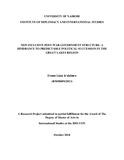| dc.description.abstract | Empirical evidence shows that balance of power between nations in the Great Lakes Region is
dependent on balance of power within the individual states in this region. However, internal
balance of power is highly dependent on prevailing government structures. The government as
structured influences the power balance and hence predictability of political succession. This
study aimed at investigating this phenomenon using the DRC as a case study. It was instigated
by the understanding that peace and stability prevail when a government is perceived to be fair,
equitable, transparent and accountable. Herbert Weiss noted the challenge in many Great Lakes
Region nations is how to accommodate the different interest groups within and without the
borders in government. Like in the case of DRC, this has been an issue of concern since
independence. The main aim was to establish whether established structures are likely to solve
conflict triggers like exclusion, ethnic profiling, marginalization, and biased distribution of
national resources. The objectives were.to document the incidences of unpredictable political
succession in the Great Lakes Region, to analyze post-war government structures and to examine
the relation between post-war government structure and predictability of political succession in
the DRC. This study was anchored on the Neo-realism theoretical foundation. The realist theory
postulates that human nature is inherently selfish hence social systems as well as international
system being anarchic. All states being rational actors, they engage in war or negotiations with
clear goals and objectives. For most states in the Great Lakes Region, they sponsor conflict
based on the friend of my enemy is my enemy and the enemy of my enemy is my friend
principle. Consequently, from a realist point of view, unless my enemy is vanquished, the friend
of my enemy remains my enemy. In this research work a qualitative design, which involved indepth
study of a phenomenon or element, was applied. The sources of primary data were
publications and key informants drawn from various interest groups working in Congo. Such
target groups include the UN, International Humanitarian Agencies in Congo, Civil Society
Groups in Congo, Political Parties in Congo, Religious leaders, prominent community leaders
and Government agencies representatives. The information gathered showed that in most
countries in the Great Lakes Region, democratic ideals of equity, accountability, transparency
and inclusivity are yet to be adopted. An examination of the post-war government structures in
countries shows that decentralization has been adopted by as a way of ensuring locals participate
in governance and increasing efficiency in government service delivery. However,
decentralization units of government in this region remain susceptible to central government
manipulation. It would be informative for a further research on the impact of the different
decentralization models on future inter-state dynamics; especially for countries that have a
shared history. Secondly, all the Great Lakes countries assessed in this study have a strong
presidency and the presidents are in their last constitutional terms. It would be interesting to
investigate the succession dynamics across the region to determine whether post war-government
structures will be altered or will they be reinforced and strengthened. Finally, more research can
be studied on the possibilities and opportunities of the Great Lakes as a regional bloc. | en_US |

